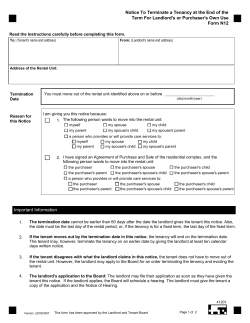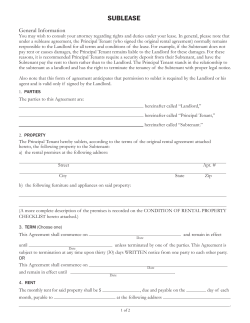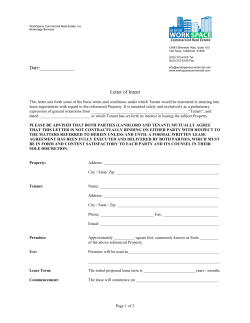
RESIDENTIAL TENANCY AGREEMENTS
RESIDENTIAL TENANCY AGREEMENTS The residential tenancy agreement, whether written or oral, cannot take away any of the rights, benefits, or protections for tenants contained in the Act. STATUTORY REFERENCES Residential Tenancies Act (RTA) sections: 1(1)(e) fixed term tenancy definition 1(1)(f) landlord definition 1(1)(h) overholding tenant definition 1(1)(i) periodic tenancy definition 1(1)(k) rent definition 1(1)(l) residential premises definition 1(1)(m) residential tenancy agreement definition 1(1)(n), 43(1), 43(2) security deposit 1(1)(t) tenant definition 2application 3 no waiver of rights 8 notice to terminate monthly tenancy 13 implied periodic tenancy 15 notice to terminate not required – fixed term tenancy 16 landlord’s covenants 17 copy of agreement to tenant 18 notice of landlord 21 tenant’s covenants 29 termination for substantial breach by tenant 38 possession unobtainable There are no sections in the Regulations relating directly to “residential tenancy agreement”. 23 GUIDELINES Renting residential premises is a business agreement between the landlord(s) and the tenant(s). Landlords and tenants agree to the terms of their business agreement in a contract called a residential tenancy agreement. This residential tenancy agreement can be written, oral or implied. It is recommended that the agreement be written so both parties have a record of what is expected. Like other contracts, the residential tenancy agreement outlines the terms of the relationship that will exist between the landlord and the tenant. It also sets out any conditions that have been agreed to by the landlord and the tenant. For example, it will probably include the rent amount, the services provided by the landlord and the responsibilities of both parties. The tenant has the option of refusing to enter into a residential tenancy agreement that contains conditions they do not want to live by. The tenant may negotiate changes to the tenancy agreement or may choose to rent elsewhere. The law relating to contracts is clear that once the landlord and the tenant both agree to the terms and conditions of the contract, it cannot be changed unless both parties agree or where allowed by legislation. The RTA applies to tenants who rent residential premises, such as houses, apartments, mobile homes and duplexes. It also applies to rooming house and boarding house residents where the landlord provides both the room and meals, as long as the landlord does not reside in the residential premises. If a tenant pays to rent living space in a hotel or motel, etc., the RTA applies if the tenant lives there for more than six consecutive months. If an employer rents residential premises to an employee, the RTA applies. The RTA does not apply to: • Mobile home sites covered in the Mobile Home Sites Tenancies Act • Business premises with living premises attached and rented under a single agreement • Rooms in the living quarters of a landlord, if the landlord actually resides there • Residential premises on military bases on federal lands • Residential premises on First Nations reserves on federal lands • Student premises at educational institutions, if students do not have exclusive possession of a selfcontained dwelling • A nursing home as defined in the Nursing Homes Act • Lodge accommodation run by a management body or by an agreement with the Minister responsible for the Alberta Housing Act • A social care facility licensed under the Social Care Facilities Licensing Act • A correctional institution • Or any other prescribed premises, which are the following: (a.) An approved hospital as defined in the Hospitals Act 24 (b.) A provincial cancer hospital operated by the Provincial Cancer Hospitals Board under the Cancer Programs Act, and The Banff Housing Corporation may refuse to give its consent to the assignment or sublease of a residential tenancy agreement under section 22(3) of the Act if: • The assignment or sublease is to a person who does not qualify as a bona fide resident under the terms of that agreement, • The assignment or sublease is to a person who does not meet the eligible resident requirements defined in the National Parks of Canada Lease and Licence of Occupation Regulations SOR/2002-237 under the Canada National Parks Act (Canada), • The tenant has not obtained the consent in writing of the Minister of Environment of the Government of Canada, or • The Banff Housing Corporation has reasonable grounds to believe that the assignment or sublease is to a person who does not meet the Corporation’s qualification requirements to acquire an interest in a residential tenancy agreement. To eliminate any “surprises” once the tenancy has begun, a residential tenancy agreement should be in writing and contain the following information: 1. Date of agreement 2. Names and addresses of all parties 3. Address or description of the location of the residential premises 4. Term of the tenancy 5. Rent amount, where, when and how it is to be paid 6. Clauses about whether utilities, furniture, appliances, parking, etc. are provided and at whose expense 7. Names of the people who are permitted to live in the residential premises 8. Security deposit amount, authorized deductions and interest 9. Care, maintenance and repair responsibilities 10. Insurance requirements 11. Rules for additional fees (such as NSF charges), guests, pets, etc. 12. Signatures of landlord and tenant. If a written residential tenancy agreement is dated August 1, 1992 or later the agreement must contain the following statement in print larger than the other print in the agreement: “The tenancy created by this agreement is governed by the RTA and if there is a conflict between this agreement and the Act, the Act prevails.” For example, if a residential tenancy agreement states a tenant has to give two months’ notice of termination for a monthly periodic tenancy agreement, this clause would be in conflict with the legislation. The RTA states that a monthly periodic tenant is required to give only one month’s notice. 25 Another conflict with the legislation would be if a residential tenancy agreement states that the tenant will have to move out immediately if the rent is not paid in full and on time. If tenants do not pay the rent, the RTA allows landlords to apply to court or RTDRS for an order terminating the tenancy and an order of possession or landlords can give tenants a 14-day notice to terminate the tenancy for substantial breach. If the tenant pays the rent before the 14 days is up, the notice to terminate is not binding and is no longer effective. A tenant cannot object to a 14-day notice that is for non-payment of rent. If the tenancy agreement is in writing, the landlord must give the tenant a copy of the agreement within 21 days after the tenant signs and returns it to the landlord. If the landlord does not provide this signed copy to the tenant within the 21 days, the tenant is allowed to withhold payment of rent until a copy is received. The RTA requires a “notice of landlord” to be given to the tenant within seven days after the tenant takes possession of the residential premises. The “notice of landlord” must contain the name of the landlord and a postal address and physical location in Canada for that person. This information can be included in the residential tenancy agreement. If the name, postal address or physical location of the landlord changes, the landlord has to provide all tenants with a new written notice of landlord, which must contain all three elements to meet the requirements of the RTA. The landlord must either give a copy to each tenant, or, in the case of projects with common areas, display a new notice where all the tenants can see it. The landlord must ensure that the notice, if placed in a common area, is replaced whenever the landlord becomes aware that the notice has been removed. Tenants and landlords should make a habit of keeping a written record of every instance when there is a problem with the other party, what was done by both of them when the problem happened, and how they each responded. A landlord may choose to offer an abatement of rent to a tenant to compensate the tenant for doing maintenance for the residential premises. This agreement should be in writing to protect both parties. In Alberta, all landlords and tenants have responsibilities (obligations). The RTA clearly identifies these obligations and they apply to every residential tenancy agreement in Alberta, whether or not they are mentioned in the terms and conditions. (see Responsibilities of Landlords and Tenants section) PRACTICAL APPLICATIONS FIXED TERM TENANCY A fixed term tenancy ends on the date specified in the residential tenancy agreement. No notice has to be given by the landlord or tenant to end a fixed term tenancy. It is courteous for the tenant and the landlord to provide the other party with a notice prior to moving out. No time frame is required for such a courtesy notice. At the end of the fixed term the landlord and tenant may both want to continue the tenancy. At this time they can negotiate a new residential tenancy agreement that could include a change in the rent amount and the conditions of the tenancy. This agreement can be a new fixed term or change to a periodic tenancy. 26 If the parties do not notify each other of their intention to continue or terminate the tenancy, difficulties may arise. For example, the landlord may be expecting the tenant to leave at the end of the fixed term and may have plans for the premises. If the tenant continues to live in the premises after the fixed term agreement ends and the landlord continues to accept their rent payments, but no new residential tenancy agreement is signed, the tenancy becomes a periodic tenancy. Once this occurs, the tenant is required to give the landlord proper notice to terminate the tenancy. OVERHOLDING TENANT If the tenant stays in the premises without the landlord’s approval, the tenant becomes an overholding tenant. The landlord can apply to the courts or RTDRS for an Order for Possession of the property from an overholding tenant. IMPLIED PERIODIC TENANCY The RTA states an implied periodic tenancy is a combination of a fixed term tenancy and a periodic tenancy. If the tenant stays in the premises after the end of the fixed term period with the implied consent of the landlord, the tenancy continues as a periodic tenancy. If the fixed term was for one month or more, the periodic tenancy becomes a monthly tenancy. If the fixed term was for less than one month, the periodic tenancy becomes a weekly tenancy. The rules of periodic tenancies then apply to this tenancy. If the tenant or the landlord wants to terminate the agreement, they will have to give the proper notice. PERIODIC TENANCY A periodic tenancy renews or continues weekly, monthly or yearly without notice. The termination and rent increase provisions contained in the RTA apply to the tenancy. ADDITIONAL FEES & CHARGES The RTA does not prohibit the landlord and tenant from agreeing to fees and charges in addition to the security deposit and rent. The residential tenancy agreement should state any additional fees or charges, the circumstances that will give rise to them, and whether they are refundable or non-refundable. It is a good idea for landlords to give receipts for any payments from tenants. (see Residential Tenancy Agreements – Fees and Charges section). A landlord cannot charge a security deposit plus an additional refundable “deposit”, if the total amounts of all refundable deposits exceed the amount of the first month’s rent. 27 FORMS Residential Tenancy Agreement forms are available at a nominal cost from a number of organizations including Landlord and Tenant Advisory Boards, the Calgary Residential Rental Association or the Edmonton Apartment Association. Since the RTA does not require a particular form of residential tenancy agreement, landlords and tenants are free to use whatever form best suits their particular needs. However, the agreement cannot take away any of the rights, benefits or protections contained in the Act. (see the Resources and Referral Information section for contact information for organizations that sell pre-printed Residential Tenancy Agreement forms.) 28
© Copyright 2025


![Sample Letter: Improper Rule Change/Fee or Rent Increase [Date] [Landlord/Manager’s Name]](http://cdn1.abcdocz.com/store/data/000031198_2-6d3ce7b943ede5629a20f08c47060981-250x500.png)







